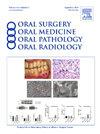识别和诊断hpv驱动的口腔上皮内瘤变由卫生保健专业人员:一个病例系列
IF 1.9
3区 医学
Q2 DENTISTRY, ORAL SURGERY & MEDICINE
Oral Surgery Oral Medicine Oral Pathology Oral Radiology
Pub Date : 2025-07-21
DOI:10.1016/j.oooo.2025.04.007
引用次数: 0
摘要
人乳头瘤病毒(HPV)是一种众所周知的病毒,可在多个解剖部位诱导肿瘤发生。在头颈部,口咽癌在最近几十年变得普遍。值得注意的是,hpv驱动的发育不良可以在口腔中看到,这是一个在体检中很容易看到的部位。了解口腔常见部位和受hpv相关口腔上皮内瘤变影响的患者群体可以使牙科医生和病理学家早期发现和诊断。本研究的目的是在患者人群和表现的背景下描述hpv驱动的上皮内瘤变病例,并提高对这一鲜为人知的实体的认识。方法选取2020年5月至2022年6月诊断为口腔上皮内瘤变的4例患者。对每个病例的患者人口统计学、初始表现、组织学、免疫组织化学和原位杂交结果进行评估。结果所有病例均表现在舌腹和/或口腔底部。1例为免疫功能低下的非吸烟者,其余3例为吸烟者。所有病例p16免疫组化均呈阳性,原位杂交鉴定出3例高危HPV亚型。组织学表现为全层增生、鳞状异常增生,细胞核深染多形性,有丝分裂增多,凋亡小体增多,变异性角化伴角化异常。结论:了解口腔上皮发育不良是如何表现的,有助于识别和诊断口腔上皮发育不良,免疫功能低下的成年男性是风险最高的患者群体。值得注意的是,这里所示的大多数病例具有非典型的吸烟史,这不是hpv驱动病变的常见相关危险因素。牙科医生推广HPV疫苗接种和卫生保健专业人员早期发现这些前驱病变可以减少口腔浸润性鳞状细胞癌。本文章由计算机程序翻译,如有差异,请以英文原文为准。
Identification and diagnosis of HPV-driven oral intraepithelial neoplasia by healthcare professionals: a case series
Introduction
Human papillomavirus (HPV) is a well-known virus that can induce oncogenesis in multiple anatomic locations. In the head and neck, oropharyngeal carcinoma has become prevalent in recent decades. Notably, HPV-driven dysplasia can be seen in the oral cavity, an easily visualized site during physical exam. Understanding of common sites in the oral cavity and the patient populations affected by HPV-associated oral intraepithelial neoplasia can lead to early detection and diagnosis by dental practitioners and pathologists. The aim of this study is to describe cases of HPV-driven intraepithelial neoplasia in the context of patient population and presentation and to raise awareness of this lesser-known entity.
Methods
Four cases diagnosed as oral intraepithelial neoplasia were identified between May 2020 and June 2022. Patient demographic, initial presentation, histology, immunohistochemical, and in situ hybridization results were evaluated for each case.
Results
All cases presented in the ventral tongue and/or floor of mouth in adult males. One case was in an immunocompromised nonsmoker and the remaining three cases were in smokers. Immunohistochemistry for p16 was positive in all cases and high-risk HPV subtypes were identified in three cases by in situ hybridization. Histology showed full thickness, hyperplastic squamous dysplasia with hyperchromatic and pleomorphic nuclei, increased mitoses and apoptotic bodies, and variable keratosis with dyskeratosis in all cases.
Conclusion
Identification and diagnosis of this subset of oral epithelial dysplasia is facilitated by knowledge of how this entity presents itself, with immunocompromised adult males being the patient population at highest risk. Notably, the majority of cases illustrated here had an atypical presentation with a smoking history, which is not a commonly associated risk factor for HPV-driven lesions. Promotion of HPV vaccination by dental practitioners and early detection of these precursor lesions by healthcare professionals can lead to a decrease in oral cavity invasive squamous cell carcinoma.
求助全文
通过发布文献求助,成功后即可免费获取论文全文。
去求助
来源期刊

Oral Surgery Oral Medicine Oral Pathology Oral Radiology
DENTISTRY, ORAL SURGERY & MEDICINE-
CiteScore
3.80
自引率
6.90%
发文量
1217
审稿时长
2-4 weeks
期刊介绍:
Oral Surgery, Oral Medicine, Oral Pathology and Oral Radiology is required reading for anyone in the fields of oral surgery, oral medicine, oral pathology, oral radiology or advanced general practice dentistry. It is the only major dental journal that provides a practical and complete overview of the medical and surgical techniques of dental practice in four areas. Topics covered include such current issues as dental implants, treatment of HIV-infected patients, and evaluation and treatment of TMJ disorders. The official publication for nine societies, the Journal is recommended for initial purchase in the Brandon Hill study, Selected List of Books and Journals for the Small Medical Library.
 求助内容:
求助内容: 应助结果提醒方式:
应助结果提醒方式:


